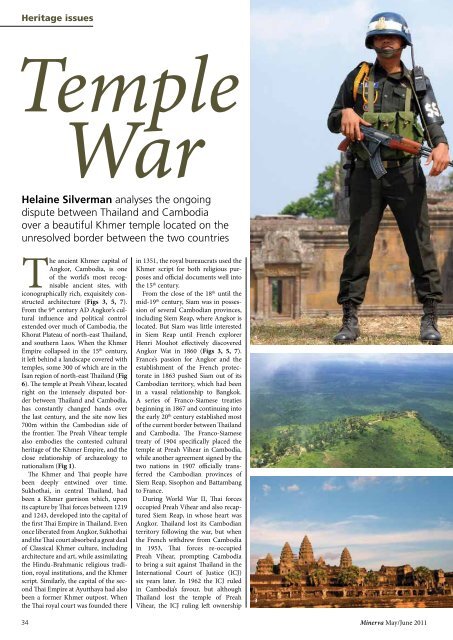Cult of beauty - Minerva
Cult of beauty - Minerva
Cult of beauty - Minerva
You also want an ePaper? Increase the reach of your titles
YUMPU automatically turns print PDFs into web optimized ePapers that Google loves.
Heritage issues<br />
Temple<br />
War<br />
Helaine Silverman analyses the ongoing<br />
dispute between Thailand and Cambodia<br />
over a beautiful Khmer temple located on the<br />
unresolved border between the two countries<br />
The ancient Khmer capital <strong>of</strong><br />
Angkor, Cambodia, is one<br />
<strong>of</strong> the world’s most recognisable<br />
ancient sites, with<br />
iconographically rich, exquisitely constructed<br />
architecture (Figs 3, 5, 7).<br />
From the 9 th century AD Angkor’s cultural<br />
influence and political control<br />
extended over much <strong>of</strong> Cambodia, the<br />
Khorat Plateau <strong>of</strong> north-east Thailand,<br />
and southern Laos. When the Khmer<br />
Empire collapsed in the 15 th century,<br />
it left behind a landscape covered with<br />
temples, some 300 <strong>of</strong> which are in the<br />
Isan region <strong>of</strong> north-east Thailand (Fig<br />
6). The temple at Preah Vihear, located<br />
right on the intensely disputed border<br />
between Thailand and Cambodia,<br />
has constantly changed hands over<br />
the last century, and the site now lies<br />
700m within the Cambodian side <strong>of</strong><br />
the frontier. The Preah Vihear temple<br />
also embodies the contested cultural<br />
heritage <strong>of</strong> the Khmer Empire, and the<br />
close relationship <strong>of</strong> archaeology to<br />
nationalism (Fig 1).<br />
The Khmer and Thai people have<br />
been deeply entwined over time.<br />
Sukhothai, in central Thailand, had<br />
been a Khmer garrison which, upon<br />
its capture by Thai forces between 1219<br />
and 1243, developed into the capital <strong>of</strong><br />
the first Thai Empire in Thailand. Even<br />
once liberated from Angkor, Sukhothai<br />
and the Thai court absorbed a great deal<br />
<strong>of</strong> Classical Khmer culture, including<br />
architecture and art, while assimilating<br />
the Hindu-Brahmanic religious tradition,<br />
royal institutions, and the Khmer<br />
script. Similarly, the capital <strong>of</strong> the second<br />
Thai Empire at Ayutthaya had also<br />
been a former Khmer outpost. When<br />
the Thai royal court was founded there<br />
34<br />
in 1351, the royal bureaucrats used the<br />
Khmer script for both religious purposes<br />
and <strong>of</strong>ficial documents well into<br />
the 15 th century.<br />
From the close <strong>of</strong> the 18 th until the<br />
mid-19 th century, Siam was in possession<br />
<strong>of</strong> several Cambodian provinces,<br />
including Siem Reap, where Angkor is<br />
located. But Siam was little interested<br />
in Siem Reap until French explorer<br />
Henri Mouhot effectively discovered<br />
Angkor Wat in 1860 (Figs 3, 5, 7).<br />
France’s passion for Angkor and the<br />
establishment <strong>of</strong> the French protectorate<br />
in 1863 pushed Siam out <strong>of</strong> its<br />
Cambodian territory, which had been<br />
in a vassal relationship to Bangkok.<br />
A series <strong>of</strong> Franco-Siamese treaties<br />
beginning in 1867 and continuing into<br />
the early 20 th century established most<br />
<strong>of</strong> the current border between Thailand<br />
and Cambodia. The Franco-Siamese<br />
treaty <strong>of</strong> 1904 specifically placed the<br />
temple at Preah Vihear in Cambodia,<br />
while another agreement signed by the<br />
two nations in 1907 <strong>of</strong>ficially transferred<br />
the Cambodian provinces <strong>of</strong><br />
Siem Reap, Sisophon and Battambang<br />
to France.<br />
During World War II, Thai forces<br />
occupied Preah Vihear and also recaptured<br />
Siem Reap, in whose heart was<br />
Angkor. Thailand lost its Cambodian<br />
territory following the war, but when<br />
the French withdrew from Cambodia<br />
in 1953, Thai forces re-occupied<br />
Preah Vihear, prompting Cambodia<br />
to bring a suit against Thailand in the<br />
International Court <strong>of</strong> Justice (ICJ)<br />
six years later. In 1962 the ICJ ruled<br />
in Cambodia’s favour, but although<br />
Thailand lost the temple <strong>of</strong> Preah<br />
Vihear, the ICJ ruling left ownership<br />
1<br />
3<br />
2<br />
<strong>Minerva</strong> May/June 2011

















